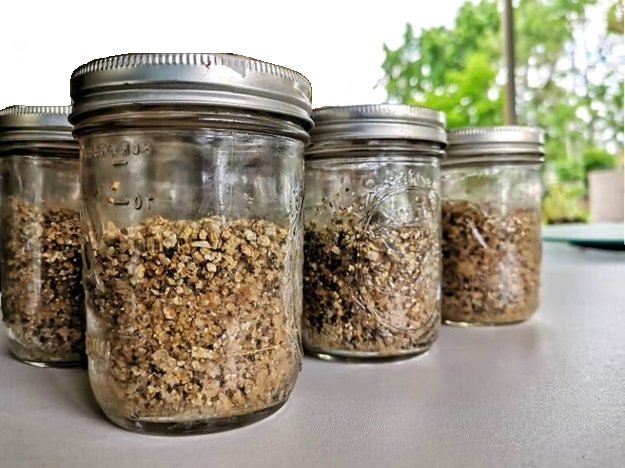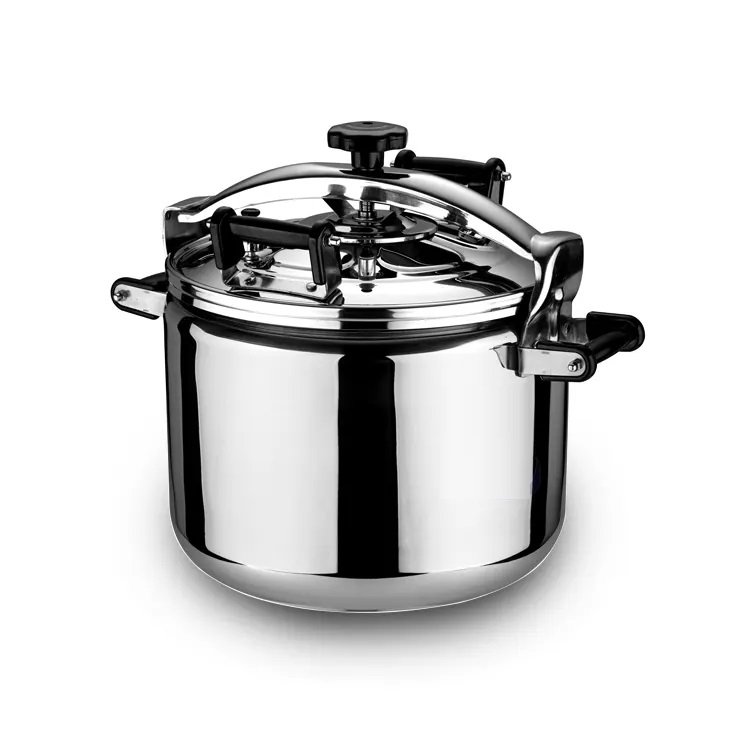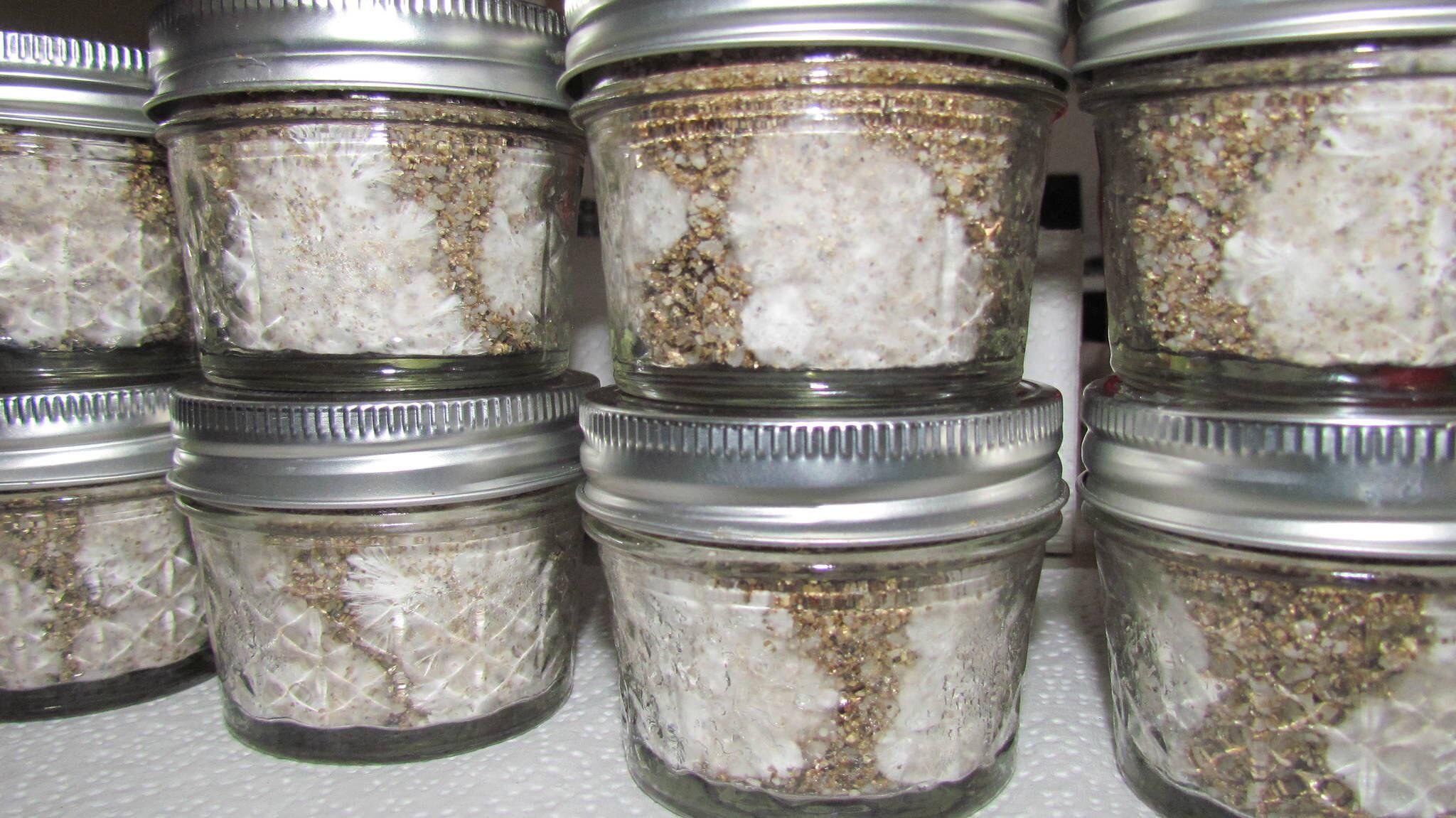The Power of The Magical PF Tek
Introduction:
I always get asked what other techniques “Tek” or substrates I could use to grow exotic mushrooms or medicinal mushrooms. The creator of the technique was non-other than the Pioneer Professor Robert McPherson, Psylocybe Fanaticus himself. This “Tek” is quite simple, cost effective, and high yielding for growing mushrooms at home and is often the first method hobbyist mushroom growers will stumble upon on their Mycology Journey. The method involves hydrating a mixture of brown rice flour, vermiculite, and perlite till it has a consistency of slightly dry dough. The mixture requires to be sterilized in an autoclave before inoculation with spores or liquid culture, the resulting fruiting bodies or mushrooms can be used for culinary purposes, medicine, or research purposes. With this step-by-step guide, anyone can start growing their own delicious, nutritious, and organic mushrooms in a cost-effective sustainable way.
Pre-Made PF Tek (Brown Rice Flour, BRF) Substrate Jars
If you’re in a crunch and want to enjoy growing mushrooms without the hassle of preparing your own Sterilized Substrate, you can always let us handle that for you and purchase are Sterile Pre-Made PF-Tek Cakes. These come with an Injection Port and a Filter Patch, perfect for inoculating with syringes.
Enjoy the benefits of our locally made and sourced BRF Cakes:
Ready to use, which saves time and effort compared to preparing the substrate from scratch. Perfect for beginners.
Sterilized at with industrial High Pressure and Temperature Autoclave, reaching True Sterilization.
Strict Quality Control when preparing our BRF Jars eliminating variabilities in performance and yield.
Increase predictability and colonization times.
Cost, Time, and Space effective for small hobbyist growers. Remove the need to purchase specialtiy equipment.
Buying our Ready to use PF Tek BRF Cakes for mushroom growing is a convenient and cost-effective way to get started with mushroom cultivation and can increase the chances of successful mushroom growth.
PF-Tek Components & Shopping List
6 x 250ml Wide Mouth Mason Jars
6 x Mushroom Growing Lids with Injection Port and Filter Patch
1000 ml of Vermiculite
500 ml of Brown Rice Flour
500 ml of Clean Water (Un-chlorinated)
1000 ml of Perlite
Aluminum Foil
Autoclave or Pressure Cooker
Before we delve to deep into the process of making our own PF Tek BRF Cakes we should understand the basics of what and why each component is being used for mushroom cultivation.
What Is Vermiculite?
Vermiculite is commonly used as a component in mushroom growing substrates. When mixed with other materials such as peat moss, coco coir, and gypsum, it can create an ideal growing environment for many species of mushrooms.
One of the key benefits of vermiculite in mushroom growing is its ability to hold moisture while also providing aeration to the substrate. This is important for the growth and development of the mycelium, which is the vegetative part of the mushroom that feeds on the substrate.
Vermiculite is also an excellent source of trace minerals that are important for the growth of mushrooms. It is sterile and inert, which means that it does not contain any harmful bacteria or fungi that could compete with the mushroom mycelium.
In addition to being used in substrate formulations, vermiculite can also be used as a casing layer for mushroom cultivation. A casing layer is a thin layer of material that is placed on top of the substrate to help maintain moisture levels and provide a good environment for the formation of fruiting bodies (mushrooms).
Overall, vermiculite is a valuable component in mushroom growing due to its ability to retain moisture, provide aeration, and supply important nutrients to the mycelium.
What is Brown Rice Flour?
Brown rice flour is a popular ingredient used in the preparation of mushroom substrate for growing certain species of mushrooms. It is a finely ground flour made from brown rice that has been milled to a powder consistency.
In mushroom cultivation, brown rice flour is often mixed with other materials such as vermiculite, coco coir, and gypsum to create a nutritious substrate that provides the necessary nutrients and structure for the growth of mycelium and happy mushrooms.
Mycelium is the vegetative part of the mushroom that grows in the substrate before forming fruiting bodies (mushrooms). Brown rice flour is a great source of carbohydrates, which is an essential nutrient for the growth of mycelium.
The use of brown rice flour in mushroom cultivation has several advantages. It is readily available and relatively inexpensive compared to other substrates. It also has the added benefit of being gluten-free, which makes it a good option for those with gluten sensitivities.
Another advantage of using brown rice flour is that it is a sterile substrate, which means it is free from harmful bacteria and fungi that can compete with the mushroom mycelium. This makes it a reliable option for mushroom cultivation.
Overall, brown rice flour is a useful ingredient for mushroom cultivation due to its nutrient content, availability, and sterility. It is commonly used in the preparation of substrate for growing species such as the popular culinary mushroom, the shiitake. Although, it is often used for people to grow Magic Mushrooms.
What is Perlite?
Perlite is a common ingredient used in the PF Tek (short for Psylocybe Fanaticus Technique), which is a popular method for growing psilocybin mushrooms at home. Perlite is used in the PF Tek to create a suitable environment for the growth of mushroom mycelium.
Perlite is a naturally occurring volcanic glass that has been heated and expanded to form lightweight, porous particles. When added to the PF Tek substrate, perlite helps to create a loose and airy texture that allows for proper air exchange and water retention.
The PF Tek substrate typically consists of brown rice flour, vermiculite, and water. Perlite is added to the mixture to help regulate the moisture content of the substrate and create a more breathable environment for the mycelium to grow.
During the colonization phase, which is when the mushroom mycelium grows through the substrate, the perlite helps to prevent the substrate from becoming too wet or compacted, which can impede mycelium growth. The porous nature of perlite also allows for proper air exchange, which is important for the mycelium to thrive.
Overall, perlite is a valuable component in the PF Tek for mushroom cultivation as it helps to create a suitable environment for the growth of mushroom mycelium. Its lightweight and porous properties make it a popular choice for creating a substrate that is easy to work with and provides the necessary conditions for successful mushroom cultivation.
PF Tek Step-By-Step
Alright, now that we made it through the basics and understand what PF-Tek is, we got to know how to prepare it and understand how to use it! The time required to prepare and successfully fruit Mushrooms can vary depending on several key environmental parameters.
Type of Mushroom: Different mushrooms will have their own colonization and growth rates, even certain strains will have different rates based on the strength of the specific culture.
Environmental Conditions: The Relative Humidity, Temperature, Lighting, and Air Exchange in the colonization and fruiting environment will significantly impact the growth rate of the mycelium.
Sterilization Time: This will often vary based on the type of equipment one uses for pressure cooking, not all autoclave/pressure cookers operate at the same Temperature or Pressure. This will vary greatly between residential “home” use models.
A great rule of thumb I usually follow when preparing harvests and production schedules is to plan about 6 weeks in advance. Here is an estimate on the amount of time it takes to prepare and harvest mushrooms.
Preparation of the BRF cakes: 2 days.
Inoculation of the BRF cakes: 1 day.
Colonization of the BRF cakes: 2 to 4 weeks (Depending on the strain of the mushroom)
Fruiting of the mushrooms: 1 to 3 weeks (Depending on the strain of mushroom)
Harvesting of the mushrooms: 1-2 days
You can expect about
4 weeks to harvest for quicker colonizing mushrooms like Grey, Pink, Blue, or Yellow Oysters.
5 weeks for Shiitake, Lions Mane, Red Reishi.
6 weeks for King Trumpets
7 to 8 Weeks for Cubensis and Magical Types
Alright, now lets get our hands dirty in preparing ourselves some PF Tek Jars and Cakes.
Step 1: Prepare the Container and Lids
We prefer to use Wide Mouth Mason Jars are they’re easy to clean, withstand high temperatures, and mainly re-usable. They’re also relatively inexpensive compared to other types of containers. The mason jar is quite smooth on the inside and will help facilitate the removal of the PF Cake once it is fully colonized and reduce the chances of us damaging our cakes upon extraction into our fruiting chambers. Modified lids are required for growing mycelium in jars. These lids feature both a filter for fresh air exchange and an injection port to allow for the injection of liquid culture or spores with minimal risk of contamination. You can Purchase Lids here or purchase materials to make lids here.
These Lids are made with a Filter Patch that provides 0.3 Micron Filtration and Passive Air Exchange. We’ve also attached a Self-Sealing or Self-Healing Injection Port that virtually eliminates and reduces the possibility of contamination. The lids can be used multiple times before the Injection port will need to be replaced.
Step 2: Preparing the Cake or “BRF batter”
Incorporate 500 ml (2 Jar) of brown rice flour and 1000 ml (4 Jars) of vermiculite before adding 375ml of the water. Gradually add the remainder of the 125 ml of water to ensure that the substrate isn’t over saturated. Ideally the moisture content within the substrate mixture will reach ‘field capacity’. When the substrate is squeezed firmly in your fist it should clump together without excess water dripping from it. Visualize ringing out a damp cloth, you want to squeeze and only should barely see a droplet forming.
It is important to note, it is better to error on the dryer side vs the wet side as dry substrates will colonize slowly or incompletely. Over saturated substrates will not colonize and potentially harbor contaminants that can grow and contaminate your growing/fruiting rooms.
Field Capacity
Growing mushrooms is a bit like making a cake! (PF Tek Cake) You need to mix together different ingredients, like flour, sugar, eggs, and butter, in the right proportions to get a cake batter that will rise and bake into a delicious cake.
In mushroom growing, one of the important ingredients is the substrate, which is the material that the mushrooms grow on. The substrate needs to have just the right amount of water in it for the mushrooms to grow properly.
Field capacity is a way of measuring how much water the substrate can hold. It's like filling up a cup with water until it's full, but not overflowing. If the substrate is at field capacity, it means it's holding as much water as it can without being too wet.
If the substrate is too dry, the mushrooms won't have enough water to grow properly. If it's too wet, there won't be enough air for the mushrooms to breathe and they might get sick.
So, field capacity is an important concept in mushroom growing because it helps us make sure the substrate has the right amount of water for the mushrooms to grow big and strong!
Step 3: Forming the Cake, Packing
Fill each 250 ml mason jar with the BRF cake batter mixture using a clean sanitized spoon. The jars should only be 1/2 – 3/4 full. Take care not to apply pressure as we don’t want to compress and compact the BRF cake mixture. A light, fluffy cake will the necessary path/porous voids necessary for mycelium breathe better and ensure a faster, more complete colonization.
(Optional) Apply a shallow layer of dry vermiculite over the top of the BRF mixture. This nutrient sparse layer of vermiculite will assist in protecting the nutrient dense substrate from contamination.
Place lids on the jars and cover with a layer of aluminium foil. Press firmly around the rim to ensure that it creates a tight seal.
Step 4: Sterilization, Heat Treatment using Steam and Pressure.
Prepare your Pressure Cooker or Autoclave to received and load your Mason Jars to sterilize. If you’re using a stove top pressure cooker you’ll want to fill it up to about half way up to the jars. If you’re using a retail pressure cooker like an InstaPot or Cooker, note that those are not rated for high pressure and will Not reach the necessary minimum 15 PSI and 121°C pressure and temperature. You can still Sterilize your PF Tek Cakes following our Guide here, for Sterilizing without High Pressure and Temperature.
You want to heat treat the PF Cakes for a minimum of 90 minutes, so the heat can penetrate the cakes thoroughly and destroy/denature any bacteria and contamination. When using a pressure cooker, you will want it to cool down back to room temperature before opening. You can Purchase one of our Pressure Cookers, these are rated for Sterilizing. We also offer Large Autoclaves for bulk sterilization.
We offer Stainless Steel Pressure Cookers/Autoclave Rated for High Pressure and Temperature Heat Treatment.
Step 5: Inoculation
This is the most crucial step, you’ll want to follow Sterilie Technique or follow our guide for inoculating in clean work space. Allow your freshly sterilized jars to cool down to room temperature, if you inoculate the Cakes when they are hot, it will kill off the mycelium.
Prepare the work space and syringe before removing the layer of aluminum foil. Using an open flame sterilize the needle and inject a 2ml’s of liquid culture or spore syringe in four quadrants. Promptly cover each hole with micro-pore tape. Flame sterilize the syringe between each jar to reduce cross contamination and potenential contamination from the air.
Evenly disperse Liquid Culture throughout the cake to allow the mycelium an opportunity to quickly colonize the nutritious Brow Rice Flour.
Step 6: Birthing
Once you see the mycelium has fully colonized the PF Cake, you’ll want to consider “Birthing” the cake, which simply means to smack the bottom of the jar till the cake plops out.
Make sure to wash your hands thoroughly, put on some clean gloves, and then you’ll want to remove the cakes from the jars, careful to not drop the cake on the floor or damage them. Although they are quite dense and firm, they will still be quite delicate and can be broken or cracked if care is not used when birthing the cakes.
The external mycelium layer will provide protection from airborne contamination, it is critical to keep it intact and not damaged. Once you have sucesfully removed the cakes, you’ll want to place them into a fruiting chamber. You can follow our guide here, we highly recommend a monotub or shotgun fruiting chamber.
Step 7: Rehydrate and Refresh
During the colonization stage the mycelium may often get thirsty as they’ve been growing in a confined environment, we want to rehydrate and refresh the Cakes by submerging them in clean water, follow our guide here on “How to make clean water.” Once you plop the cakes into water, they will tend to float, you’ll want to keep them submerged for 24 to 48 hours, after that you can roll the cakes onto some clean vermiculite (either heat treated or boiled) to help retain some of that new moisture. This step is important before introduction into the Fruiting Chamber as the water, oxygen (atmospheric environment), and light trigger the mycelium into fruiting mushrooms “reproducing”.
Step 8: Fruiting Time!
Depending on the type of mushroom you’ve selected you will need to adjust your Relative Humidity and Temperature accordingly. We often recommend to setup a monotub with a Humidifier. You can find our Mushroom Environmental Growing Schedule Guide here. We also offer small monotubs you can purchase pre-made from us to save on the hassle of drilling and cracking the plastic containers.
Step 9: Harvesting
Over the next 3 – 14 days the PF cakes will begin to form primordia or pins. These small formations will grow into mushrooms within a few days. Once mature they can be harvested making way for the next flush. I usually recommend people to gently twist and pull the mushrooms off the Cakes, this will help remove any organic material for contaminates to grow on.
After your first harvest, you’ll want to repeat Step 7 and rehydrate the Cakes for 24 to 48 hours. This will renew the Cakes and allow more mushrooms to grow.
Note: These time frames will vary depending on the species being cultivated.
Step 10: Drying
I usually like to enjoy my mushrooms as fresh as possible, but often people do like to preserve them and enjoy them in the future. The best way to preserve the nutrients and medicinal ingredients is with High Air Flow and Low Temperature. I highly recommend sandwiching the mushrooms between breathable paper or filters and blowing air through the filters. The filters will keep any contamination from growing on the mushrooms, while the airflow will dry out the mushrooms.
Conclusion:
This is the best technique or method for growing mushrooms utilizing the PF Tek or Technique for Growing Gourmet or Alternative Mushrooms. Cubensis
How to grow magic mushrooms at home utilizing PF tek.









